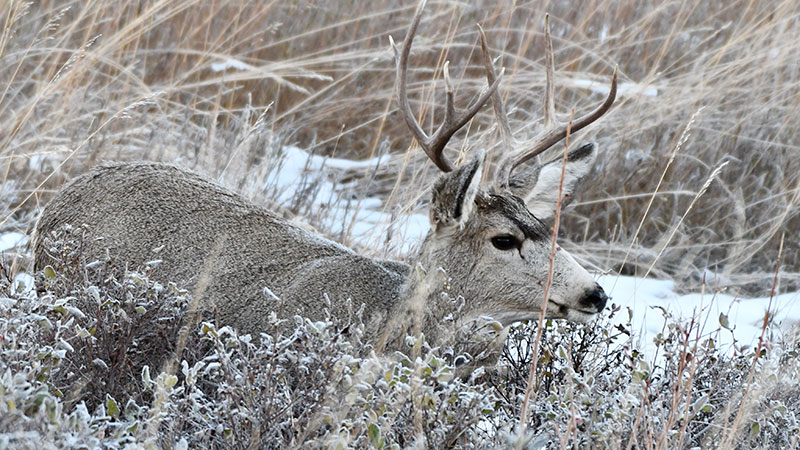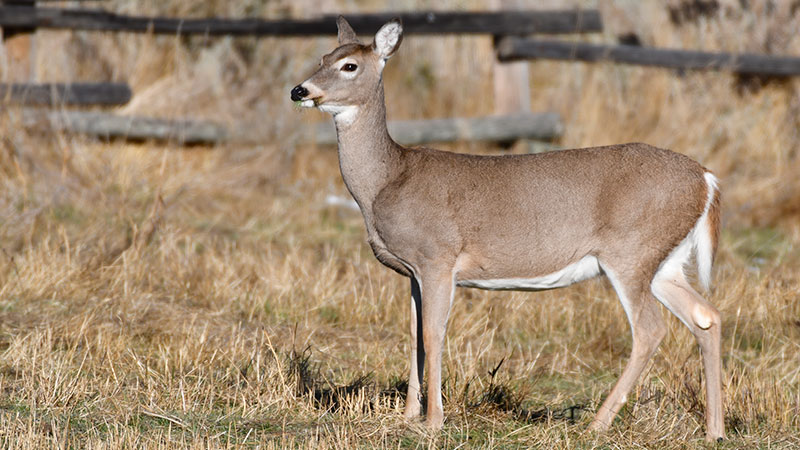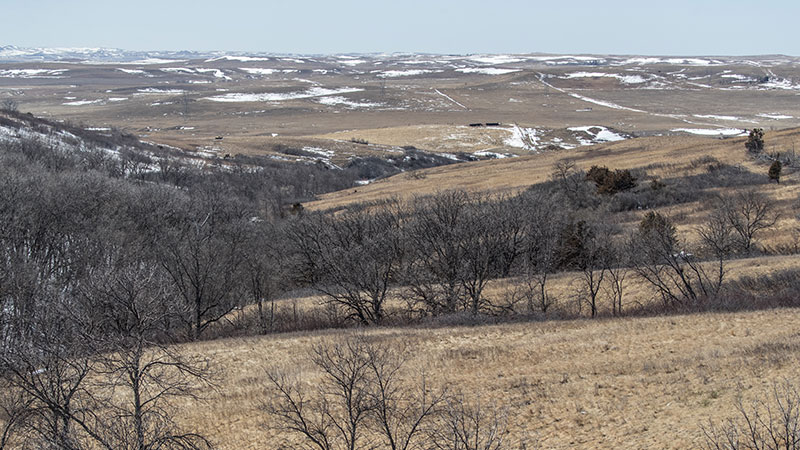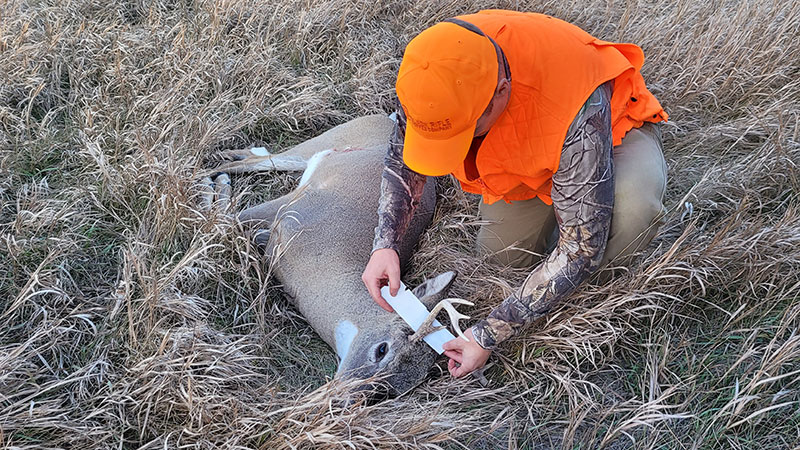Forever on the Landscape
Ron Wilson

An always fatal disease to deer and other cervids that has found some footing in North Dakota, yet has a smaller footprint compared to some other states, will forever remain on the landscape.
The reality of this, the certainty that chronic wasting disease is going nowhere and has the potential to significantly impact our big game populations if left unchecked, is sobering.
While the North Dakota Game and Fish Department has long, among other management practices, tested thousands of deer and other big game for CWD in the last 20 years, the agency tasked to protect, conserve, enhance and sustain wildlife populations for current and future use, has upped the ante in this continued threat.
A CWD task force of agency employees from several divisions was formed in 2021, according to Jeb Williams, Department director, to review the science of CWD, evaluate the status of CWD management in North Dakota, and chart a best path forward while folding in lessons across North America over decades.
“For the past 20 years, our Department has been working pretty hard to keep up with it. We’ve tested over 40,000 deer. We’ve followed the science and applied our different tools to the extent that made sense and we were able,” said Dr. Charlie Bahnson, Department wildlife veterinarian. “And, by and large, we’re happy with the results that’s gained us. But here we are 20 years later, and it’s time to stop and do a comprehensive reassessment of where we’re at and where we hope to go.”
Department officials held three public meetings in late summer in Fargo, Dickinson and Minot to update those in attendance about the status of CWD in the state and how Game and Fish hopes to address the disease in the future.
“The task force had some fairly broad topics or purposes, the first was this status review of CWD surveillance and management in North Dakota, and after that we read nearly all of the state wildlife management plans for CWD that are available across the country,” Bahnson said. “There were some really good ones, some less good ones, but hopefully we took the best parts of those plans and folded them into what we’re doing. We were looking at what management options are out there that make sense to apply here in North Dakota.”
CWD, caused by a prion protein that leads to irreversible damage to the nervous system, was first identified in North Dakota in mule deer in 2009 and white-tailed deer in 2013.
In total, according to Bahnson, CWD has been found in eight deer gun hunting units in North Dakota. Fortunately, while a number of deer have tested positive for the disease, the prevalence of CWD remains low, from 2-5% in affected units.
The Department’s updated CWD management and surveillance plan will not go into play until 2023. Hunters will recognize at that time changes to carcass transportation regulations and adjustments to surveillance efforts. Regulations regarding baiting will remain as is.
Concerning hunter-harvested surveillance, the plan reads in part: Beginning in 2023, a deer gun unit will be surveyed less frequently but more thoroughly. Relative to other diseases, CWD progresses slowly. This means that annual changes are less meaningful than longer term trends. Therefore, the Department will focus resources on one-fifth of deer gun units annually, ultimately resulting in less frequent but more accurate prevalence estimates. A sampling goal will be set at 10% of allocated deer gun licenses for a given year.
CWD testing in North Dakota began in 1998 with roadkilled, sick and suspect animals. In the early 2000s, the Department increased surveillance efforts by annually collecting hunter-harvested deer, elk and moose.
Typically, surveillance efforts from hunter-harvested deer focused on a third of the state on a rotating basis, and those areas where wildlife managers are trying to manage CWD.
Participation by hunters has never been great.
“Thank you to anybody in the room that’s ever contributed a sample because that’s very important. But you’re actually kind of a minority despite a lot of effort, we could just very rarely ever get more than 5% of license holders to turn in a head for sampling,” Bahnson said at the public meeting in Dickinson in August. “And that just translated to very imprecise data and it’s hard to make important decisions based off such incomplete data. Moving forward, we plan to divide the state into smaller units. Instead of going kind of a mile wide and inch deep, we plan to split it up into fifths and test much harder, making use of different sample sources to get to our surveillance goals.”
Bahnson readily acknowledges that baiting generates a lot of spirited conversation within North Dakota’s deer hunting community. Even so, he’s quick to point out the fallout from baiting, from congregating groups of deer for sometimes months at a time, because it’s understood how the disease is spread from deer to deer.
“We know that deer can be infected in a variety of ways, through direct contact with another infected animal, through indirect contact, through environments contaminated with bodily fluids – urine, saliva, feces – from an infected deer,” he said. “And then even we know that carcasses that are infected, that are left out in the landscape, can be a source of infection for years afterwards.
“But regardless of how it happens, once a deer becomes infected, the clock starts ticking. And in about a year and a half to two years, it’ll reach this point where it starts to rapidly lose body condition,” he added. “It’s excessively urinating, salivating. It becomes what we call neurologic. It’s got a disease of the brain and is acting erratically, but it invariably will die. It’s 100% fatal.”
The bait ban issue in the 2023 plan remains status quo, and reads in part: The Department will continue to reduce the risk of CWD transmission through its ability to regulate baiting as a method of take. Baiting will be restricted via CWD proclamation in any deer gun unit that falls within 25 miles of a previous detection.
For the 2022 hunting season, it is illegal to hunt big game over bait, or place bait to attract big game for the purpose of hunting, in deer units 1, 2B, 3A1, 3A2, 3A3, 3A4, 3B1, 3C, 3D1, 3D2, 3E1, 3E2, 3F1, 3F2, 4A, 4B, 4C, 4D, 4E and 4F. It is also illegal to hunt big game over bait or place bait on any Game and Fish Department wildlife management area.
“When we think about keeping the infection rate low in CWD positive areas, we realize that anything that is going to bring these animals into congregation or bring them close together is going to increase these direct contacts and these indirect contacts,” Bahnson said. “The more often that happens, the more intense it happens, the longer that it happens, the faster that we’re going to perpetuate this disease. And importantly, again, there’s that environmental contamination component. If we have these concentrated areas where there’s a lot of biological buildup of urine, saliva, feces, even after these deer are gone, we provide potential areas to perpetuate the problem moving forward.”
Department wildlife managers understand that hunters remain the best and most important tool in slowing the spread of CWD in North Dakota, and an effort to improve hunter access to maximize this tool is ongoing.
“We’ve long said that a hunter’s gun is our most important tool for managing this issue and frankly, for managing most of our wildlife issues. And if you think about it, it makes sense,” Bahnson said. “We have identified areas that certainly have higher infection rates. So, if we can focus some harvest, particularly around those areas, we do a number of things. One, we get positive animals off the landscape sooner, so we’re decreasing how many animals those positive animals are going to infect. Also, if we decrease deer density, we discourage deer from moving out of the infected areas … we hopefully influence net movement inward instead of outward.”
Current (2022) Big Game Transport Regulations
Big game hunters should note requirements for transporting deer, elk and moose carcasses and carcass parts into and within North Dakota, as a precaution against the possible spread of chronic wasting disease.
Hunters are prohibited from transporting into or within North Dakota the whole carcass of deer, elk, moose or other members of the cervid family harvested outside of North Dakota.
In addition, hunters harvesting a white-tailed deer or mule deer from deer hunting units 3A1, 3A2, 3B1, 3C, 3D1, 3E2, 3F2, 4B and 4C, a moose from moose hunting units M10 and M11, or an elk from elk hunting units E2 and E6, cannot transport the whole carcass outside the unit. However, hunters can transport the whole carcass between adjoining CWD carcass restricted units.
North Dakota Game and Fish Department district game wardens will be enforcing all CWD transportation laws.
Hunters are encouraged to plan accordingly and be prepared to quarter a carcass, cape out an animal, or clean a skull in the field, or find a taxidermist or meat locker within the unit or state to assist.
Game and Fish maintains several freezers throughout the region for submitting heads for CWD testing.
For questions about how to comply with this regulation, hunters should contact a district game warden or other department staff ahead of the planned hunt.
The following lower-risk portions of the carcass can be transported:
- Meat boned out.
- Quarters or other portions of meat with no part of the spinal column or head attached.
- Meat cut and wrapped either commercially or privately.
- Hides with no heads attached.
- Skull plates with antlers attached and no hide or brain tissue present.
- Intact skulls with no visible brain or spinal cord tissue present that has the eyes, lower jaw, tongue, salivary glands, tonsils and lymph nodes removed.
- Antlers separated from the skull plate.
- Upper canine teeth, also known as buglers, whistlers or ivories.
- Finished taxidermy heads.
- Lymph nodes extracted from the head for CWD testing contained within a sealed, plastic bag.
There is an exception to the regulation that reads “a deer carcass or boned-out meat must be accompanied by the head to the final place of storage.” The exception is: Tag the deer as required, then take two photographs using a cellphone with location, date and time stamp turned on. One photograph of the entire animal at the kill site with tag attached, and a second photograph of a closeup of the tag so that the tag information is readable. If a hunter leaves the head in the field at the kill site, after taking photos and saving them, the ear or antler with the tag attached must be cut off and accompany the meat or carcass while in transport. The photographs of the tagged deer must be shown to any game warden or other law enforcement officer upon request.





